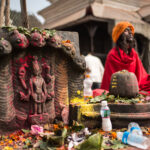Maha Shivaratri is celebrated on the Krishna Paksha of Phalguna month, which results in different dates every year. This year, it takes place on February 18. The following day after midnight, puja is celebrated with feasting, fairs, and more. Many people also observe a fast on this day. Members of the South Indian Lingayat sect give gifts to their gurus or spiritual guides. Maha Shivaratri directly translates to ‘the Great Night of Shiva,’ as it is presumably the night Shiva performed the Tandava Nritya, a dance of preservation, creation, and destruction. It is also believed to be the night Shiva drank the poison of negativity, holding it in his throat to save the world, which in turn turned his throat blue. Another belief is that this was the day Shiva reunited with his love Parvati.
History of Maha Shivaratri
Maha Shivaratri is a major Hindu festival celebrated in honor of the god Shiva. It also refers to the night when Lord Shiva performs the heavenly dance of creation, preservation, and destruction. There are 12 Shivaratris in a year; however, Maha Shivaratri is especially auspicious. This night marks the convergence of Shiva and Shakti, which means the masculine and feminine energies that balance the world.
In Hinduism, this is a solemn festival marking the overcoming of darkness and ignorance in life. It is reserved for introspection and leaving behind things that come in the way of success and growth. It is a day where one can work towards letting go of sins, embarking on a journey of righteousness, and ultimately attain moksha on judgment day.
The celebrations take place across India according to the customs dictated in the region. Many people celebrate early in the morning, while some perform puja all night. Devotees even observe a day-long fast, only breaking it the next day after a bath. This fast is more of a test of one’s determination rather than to attain blessings. In 1864, Alexander Cunningham documented a fair and dance festival on Maha Shivaratri that took place at Khajuraho Shiva temples, involving Shaiva pilgrims camped over miles around the temple complex.
Outside India, Nepal also celebrates Maha Shivaratri, and it is, in fact, a national Holiday. The main celebration takes place in the Pashupatinath temple. Even in Pakistan, the Hindus visit Shiva temples, and the most important festival is the three-day affair in the Umerkot Shiv Mandir.
Maha Shivaratri is thus an extremely sacred day to Hindus across the globe and is observed with much enthusiasm.
Maha Shivaratri timeline
Shiva is used as an adjective in the Rig Veda.
Rudra's evolution to a supreme being from a minor deity is evidenced in the Shvetashvatara Upanishad.
The literature surrounding Shiva starts to extensively develop across India.
“Om Namah Shivay,” a series based on Hindu Puranic tales and stories of Lord Shiva, is released.
Maha Shivaratri FAQs
What is Maha Shivratri in Hinduism?
Maha Shivaratri is the most important festival of the year for devotees of the Hindu god Shiva.
What time does Maha Shivaratri start?
The Masik Shivaratri puja is performed at midnight, also known as Nishita Kaal. It starts with performing ‘Abhishek’ for Lord Shiva or Shiva Lingam.
Which color should one wear on Shivratri?
On Maha Shivratri, devotees take an early bath and wear auspicious green-colored clothes before heading to the Shiva temple to offer prayers.
How to Observe Maha Shivaratri
Observe a fast
Many devotees observe a fast on Maha Shivaratri. The only permissible items on this day are fruits, milk, and dishes that include fast-compliant ingredients. It is advisable to stay away from any consumption of meat, alcohol, and tobacco.
Visit a Shiva temple
Head to a nearby Shiva temple at midnight and soak in all the positive vibrational energies during the midnight puja. It is a one-of-a-kind experience. Offer prayers to Lord Shiva and take an oath to work on yourself and walk on the path of righteousness.
Take time to self-reflect
Maha Shivaratri is a solemn festival; apart from performing puja and carrying out rituals, you can also take out time to self-reflect. Understand how your actions affect yourself and the ones around you. Take necessary remedial measures if need be.
5 Important Facts About Lord Shiva
Trimurti
Lord Shiva is part of the three supreme Hindu gods who make the Trimurti; Brahma, the creator, Vishnu, the preserver, and Shiva, the destroyer.
Lord Shiva’s wife
Lord Shiva’s wife is Parvati, the Hindu goddess of marriage, love, fertility, beauty, devotion, children, divine strength, and power.
Lord Shiva’s third eye
Lord Shiva is known to have a third eye, which is often closed as he is looking inward.
Cobra necklace
Lord Shiva wears a cobra necklace, which represents his strength and potency as a supreme god.
Shaivism
The worship of Lord Shiva is known as Shaivism.
Why Maha Shivaratri is Important
It encourages introspection
Maha Shivaratri is a day that encourages introspection. One must know all actions have consequences. This day reminds you to dive deep within your soul and search for answers. Analyze your actions. Learn to accept others for who they are and provide support and show people the right way.
It encourages adopting a path of righteousness
Maha Shivaratri offers a chance to leave obstacles behind and walk on a path of righteousness. By performing good deeds, it is realistic to achieve moksha. One must understand the importance of leading a true and just life separate from materialistic pleasures and sins.
It honors the Hindu god
Maha Shivaratri honors the Hindu god Shiva, who is worshipped by Hindus from every part of the world. He is known as ‘The Destroyer’ within the Trimurti. In the Shaivite tradition, Shiva is the one who creates, protects, and transforms the universe.
Maha Shivaratri dates
| Year | Date | Day |
|---|---|---|
| 2022 | March 1 | Tuesday |
| 2023 | February 18 | Saturday |
| 2024 | March 8 | Friday |
| 2025 | February 26 | Wednesday |
| 2026 | February 15 | Sunday |


















